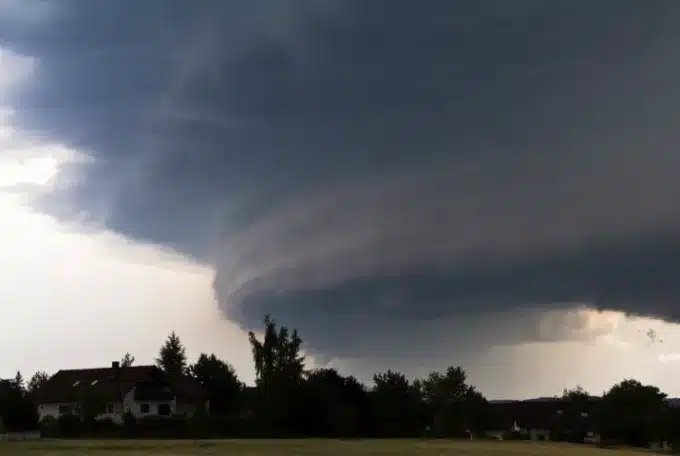What to Do During a Tornado

When you are prepared for a tornado, stick to your plan!
The moment you hear a tornado warning or suspect a tornado is nearby, you should act immediately by finding a tornado shelter. The emphasis is on minimizing your exposure to the dangerous elements of a tornado while ensuring you’re in a position to stay informed and ready to respond to changing warnings. Never try to outrun a tornado. What is most important is to stay safe.
During a tornado watch, it is crucial to monitor updates from the NOAA Weather Radio of the National Weather Service.
When Tornadoes Strike, Go to Your Pre-Identified Room
Once a warning has been issued, go to your pre-identified safe room, which should be a basement, storm cellar, or an interior room on the lowest level of a sturdy building or your home, like a bathroom or closet.
As the tornado is approaching, avoid windows, corners, doors, and outside walls. The goal is to put as many walls as possible between you and the outside. In many cases, violent tornadoes can break through your outside walls, hence you should be as far away as possible from danger.
Protect Yourself from Potential Debris
Once in your safe room, protect yourself from potential debris. Use heavy furniture, like a sturdy table, to shield yourself. When a tornado is approaching, get under something sturdy to protect against falling debris. Cover your head and neck with thick padding or a mattress and use helmets if available to protect your head from flying or falling debris. The helmet can be a bike helmet or a hard hat. It might look odd, but it could be a lifesaver. This is not the time to look fashionable.
Stay Away from Windows
Avoid windows! Windows are the first to break during a tornado if something hits them. Flying debris caused by high winds can shatter windows, turning glass into dangerous projectiles. If you can’t get to a lower level, find a hallway or a small inner room without windows.
There’s a common misconception that opening windows will equalize pressure during a tornado, but this isn’t true. It could make things more dangerous and, in reality, it’s a waste of precious time that can be potentially harmful. Instead, focus on finding safe shelter.
Don’t Stay in Your Mobile Home
If you live in a mobile home, leave it immediately and seek shelter in a safer location. Mobile homes, even if tied down, offer very little protection against tornadoes. Pay attention to tornado watches and warnings issued by authorities and act hasty. Go to a nearby building with a basement or to a designated winter weather shelter.
Be Prepared
Keep your cell phone charged and with you, so you can receive updates or call for help if necessary. However, avoid using the phone for non-emergency purposes to keep the lines open for emergency communications.
Listen to a battery-operated weather radio or a reliable weather app on your phone for updates. Local authorities will provide information about the tornado’s path and when it’s safe to leave your shelter.
Consider having emergency supplies like a sleeping bag, torch, water, and canned food to ensure your safety.
If You Are Not at Home
A tornado can catch you at work, at school, in a shop, or at a restaurant. The same tornado safety principles stand: locate the lowest possible level, avoid large open rooms, and always get as far as possible from windows. If you can’t find a basement, take shelter under something heavy like a table.
If you are in a high-rise building when the sirens blare, you won’t have time to get to the lowest floor, especially because many people will be thinking the same thing. Find the nearest stairwell or a small interior room and stay put. Elevators should be avoided at all costs. They’re traps and accidents waiting to happen.
Stay in Your Shelter Until It’s Safe to Come Out
Sometimes tornadoes are followed by additional tornadoes or other severe weather conditions such as hail or heavy storms. Stay inside your shelter until the danger has passed, not just when things seem to calm down.
Then, cautiously step out, watching for hazards like broken glass and downed power lines. Remember, the aftermath can be as dangerous as the tornado itself.
Make sure your loved ones are safe and start documenting the damage to your home, if any. The sooner you contact your insurance company, the better it is. Use videos and photos to document the damage and be as precise and meticulous as possible.
Frequently Asked Questions
What should I do the moment I hear a tornado warning?
At the first sign of a tornado warning, immediately move to your pre-determined safe room. This should be a basement, storm cellar, or an interior room on the lowest floor without windows.
What if I don’t have a basement or storm cellar?
If you don’t have a basement or storm cellar, find the most interior room on the lowest floor, such as a bathroom, closet, or hallway. The key is to put as many walls between you and the outside as possible.
Is it safe to hide under a bridge or overpass during a tornado?
No, hiding under a bridge or overpass is not safe. These structures can create dangerous wind patterns and debris can become concentrated in these areas.
How can I protect myself from debris during a tornado?
To protect yourself from debris during a tornado, use heavy furniture, like a sturdy table, or a mattress for protection. Cover yourself with thick padding and wear a helmet if available.




